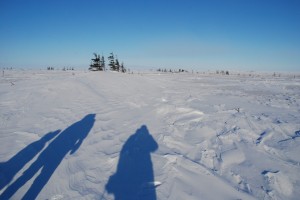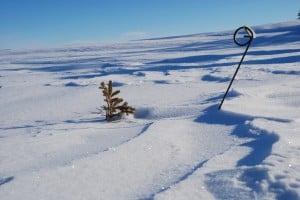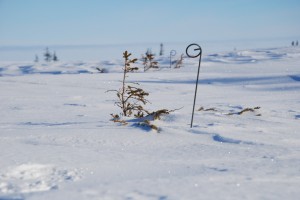February 26th @ Churchill
After another night tossing and turning, our train pulled in to Churchill Station shortly after 8 am. As soon as we stepped off the train we could feel the cold North wind on our faces. The temperature with the wind-chill came in at -30⁰C. Churchill Northern Science Centre (CNSC) was waiting there with a bus to pick up our gear and us and deliver us to the CNSC.
The CNSC, a central hub for scientists, is located on the old Rocket Range of Fort Churchill (more on this later). The centre provides accommodations, meals, lab space, and logistical support for visiting scientists as well as providing educational opportunities for groups with general interest as well as providing university level courses. Though the research site was founded in 1976, the building we are currently staying in was built just over two years ago with donations from the Provincial and Federal Governments (Yes! Federal! I couldn’t believe it either) as well as private donations. You can check out the CNSC at the following link:
http://www.churchillscience.ca/
I’ll provide more information about our life inside the facility in a later post, when I have a bit more time to take pictures of the place.
We had our first lecture today at 2 pm to prepare us for the next day’s sampling activity. Dr. Peter Kershaw will be taking us out to the tundra to sample the snow pack around tree islands. The question we were heloing to answer for this first project were:
- Does seedling recruitment drive tree line shift?
- Is survivorship of seedlings controlled by snowpack?
Now a tree island is just that – a clump of trees surrounded by tundra. They are interested in the snow around tree islands as it may impact/aid the survival of young saplings. The survival of young saplings is important because the greater the survival rate, the more readily the tree line can change.
We were divided into groups and given snow kits to sample the snow. The basic tools in the snow kit included, Adirondack snow corer, Kershaw extractor, putty knife, plastic bags, 300 g scale, 2500 g scale, compass and ruler/measure tape. We were then shuttled out to a tree island to carry out our sampling.
There are four zones around the tree island that were sampled. The zone directly in front of the island is the windward side where the wind drives straight into the island. Most winds tend to blow from the N or NW at Churchill. As the wind moves around the tree island, it gathers speed, and causes an erosion of snow on either side of the island. This is called the deflation area. The wind that passes through the island, is slowed down by the trees and therefore has a tendency to drop any snow it was carrying on the leeward side of the trees forming the leeward drift. This effect can be measured a distance that is equal to 20 times the height of the trees in the island.
A picture of a tree island with the leeward drift visible.
Using the instruments provided we measured the snow depth and snow density, 30 times, in each zone of the tree island. This data will be combined with the data collected earlier about tree saplings that were present in the area, but are now primarily under the snow pack. The next picture shows a marked sapling that is sticking out past the snow pack.
One tree pokes out farther than the other. Does snowpack have an effect?
After the lecture, we went down to sort out our cold weather gear and get fitted for snow shoes. The snow shoes were held to our boots by old bicycle tire tubes! A trick I have to remember.
[nggallery id=13]
The evening involved a lecture by “Starman”, Roger Woloshyn, on the Aurora Borealis a.k.a. the Northern Lights! Roger assured us the Churchill, MB is THE best place in the world to see Aurora! The Northern lights are caused by high energy particles emitted from the sun hitting the Earth’s atmosphere. These high energy particles hitting oxygen molecules (causing the green hue), and nitrogen molecules (causing the pink hue) excite electrons in these molecules causing them to jump to the next energy energy level. When the electrons fall back to their normal energy level they emit a photon…thus producing the light! If you want to see when the Northern Lights are going to be visible, plus tons of information on the sun, check out this great Space Weather.com (http://www.spaceweather.com) .
Some Questions to answer:
- What is a tree line?
- How old do you think the trees are in Churchill?
- What is an ecotone?
- Why do snowshoes make it easier to walk on snow?
[nggallery id=12]




